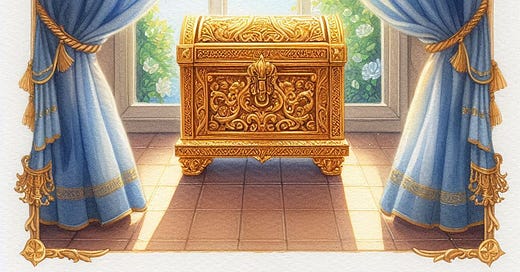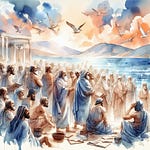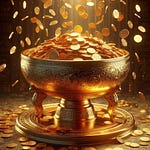NOTE: The. text of this post is different to the audio of the podcast - same information but structured differently, so I invite you to listen and also read the text and then bring the two together for yourself in a summary of this marvel of ingenuity that God gifted to Moses and the Israelites.
The Book of Exodus presents one of the most intricate and sacred blueprints ever given to mankind: the construction of the Tabernacle and the Ark of the Covenant. These structures were not merely places of worship but held deep spiritual and symbolic significance, both in ancient times and today. Through Moses, God provided specific details for the materials, dimensions, and purpose of every element, ensuring that His presence would dwell among the Israelites.
In this article, we will explore the Tabernacle, the Ark of the Covenant, and the sacred gifts that God commanded the Israelites to bring, delving into their significance then and now.
The Gifts Commanded by God
Before construction could begin, God asked the Israelites to bring specific materials as offerings for the sanctuary:
1. Precious Metals: Gold, Silver, and Bronze
Then: These metals symbolized divine purity (gold), redemption (silver), and judgment (bronze). Gold overlaid sacred objects, silver supported the sanctuary, and bronze covered the altar.
Now: Gold still represents divinity, while silver and bronze remind believers of redemption through Christ and the judgment of sin.
2. Fabrics of Blue, Purple, and Scarlet; Fine Linen and Goat Hair
Then: Each color had meaning:
Blue—heavenly nature and God's divine presence.
Purple—royalty and kingship.
Scarlet—sacrifice and atonement.
Fine linen—righteousness and purity.
Goat hair—provision and humility.
Now: These colors are still associated with God’s character and the work of Christ.
3. Ram Skins Dyed Red and Fine Leather
Then: Ram skins dyed red foreshadowed the blood of sacrifices, while fine leather (possibly dugong or badger skin) provided protection and durability for the Tabernacle.
Now: These materials symbolize Christ’s sacrifice and divine covering.
4. Acacia Wood
Then: Acacia wood was strong and resistant to decay, making it ideal for sacred furniture.
Now: It represents incorruptibility and the enduring nature of God's covenant.
5. Oil for the Lamps
Then: This pure beaten olive oil fueled the golden lampstand, symbolizing the light of God’s presence.
Now: It reminds believers of the Holy Spirit, who illuminates their path.
6. Fragrant Spices for Anointing Oil and Incense
Then: These spices, used in sacred anointing oil and incense, symbolized prayer, worship, and consecration.
Now: They continue to represent the prayers of the saints rising before God.
7. Onyx and Gemstones for the Priestly Garments
Then: The High Priest bore twelve gemstones, each engraved with a tribe’s name, signifying their representation before God.
Now: This reminds believers that God knows His people by name and that Christ, the High Priest, intercedes for them.
The Tabernacle: God's Dwelling Place
God commanded Moses to construct the Tabernacle ("Mishkan"), a portable sanctuary where He would dwell among His people. Every detail was meticulously designed, emphasizing holiness, separation, and worship.
1. The Outer Courtyard
Bronze Altar (Exodus 27:1-8): A large altar for burnt offerings represented atonement for sin.
Laver of Bronze (Exodus 30:17-21): A large basin for ceremonial washing, signifying purity before entering God’s presence.
2. The Holy Place
The Table of Showbread (Exodus 25:23-30): Held twelve loaves of bread, symbolizing God’s provision and communion with His people.
The Golden Lampstand (Menorah) (Exodus 25:31-40): A seven-branched lampstand, representing God’s eternal light.
The Altar of Incense (Exodus 30:1-10): A small golden altar where incense was burned, symbolizing prayer and intercession.
The Most Holy Place (Holy of Holies)
Separated by a thick veil, this sacred space housed the Ark of the Covenant, where God's presence dwelled.
The Ark of the Covenant: The Throne of God
The Ark of the Covenant (Exodus 25:10-22) was the most sacred item in the Tabernacle, signifying God’s presence, covenant, and guidance.
1. Construction and Symbolism
Made from acacia wood (incorruptibility) and overlaid with gold (divinity).
Carried using golden poles, emphasizing its holiness.
Topped with the Mercy Seat, where God’s presence would manifest.
2. Contents of the Ark
The Ark contained three significant items:
The Tablets of the Law – Representing God’s covenant and His divine law.
Aaron’s Rod that Budded – Symbolizing God’s chosen leadership.
A Jar of Manna – A reminder of God’s provision.
3. The Mercy Seat and the Cherubim
Above the Ark sat the Mercy Seat, flanked by two golden cherubim. Here, God would meet with Moses and provide instruction.
Then: It was a physical representation of God’s throne on earth.
Now: It foreshadows Christ, the ultimate mediator, whose sacrifice provides eternal atonement.
The Significance of the Tabernacle and the Ark Today
Though the physical Tabernacle no longer exists, its symbolism remains deeply relevant.
1. God Dwelling Among His People
Then: The Tabernacle allowed God to dwell with Israel.
Now: Through Christ and the Holy Spirit, God dwells within believers (1 Corinthians 3:16).
2. The Role of the High Priest
Then: The High Priest interceded for the people.
Now: Jesus is the ultimate High Priest, who intercedes for His followers (Hebrews 4:14-16).
3. The Mercy Seat and Christ’s Sacrifice
Then: The High Priest sprinkled blood on the Mercy Seat for atonement.
Now: Christ’s blood covers sin permanently, fulfilling the Law (Romans 3:25).
4. The Veil and Access to God
Then: A thick veil separated the people from the Holy of Holies.
Now: When Jesus died, the veil tore, signifying direct access to God (Matthew 27:51).
Some Final Thoughts for You to Ponder
The Tabernacle and the Ark of the Covenant were more than ancient artifacts; they were God’s blueprint for worship and redemption. Every detail pointed to Christ’s ultimate sacrifice, allowing mankind to enter into a direct relationship with God.
Today, the Tabernacle lives on—not in a physical tent but in the hearts of believers, where God has chosen to dwell forever.
As it is written:
"Do you not know that you are the temple of God, and that the Spirit of God dwelleth in you?" (1 Corinthians 3:16)
God’s desire has always been the same: to dwell among His people, to lead them, and to bring them into His presence.
The Tabernacle and the Ark of the Covenant were the first steps in that divine plan, a plan fulfilled through Christ and continued in the lives of all who follow Him and the Teachings He brought to humanity in His time on Earth and today, through the hearts of the peoples who believe on Him.












Share this post